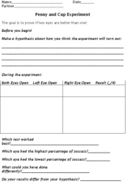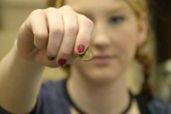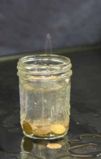Penny and Cup Game
| Instant wiki maker | Making handouts | Editing tips |
Contents
- 1 Penny and cup game
- 1.1 Student worthiness
- 1.2 Primary biological content area covered
- 1.3 Materials
- 1.4 Handouts
- 1.5 Description of activity
- 1.6 Lesson plan
- 1.7 Things to keep in mind
- 1.8 Science connections
- 1.9 Math connections
- 1.10 Literature connection
- 1.11 Connections to educational standards
- 1.12 Next steps
- 1.13 Citations and links
Biology In Elementary Schools is a Saint Michael's College student project from a course that ran between 2007 and 2010 and fully described in this book chapter. The student-created resources have been preserved here for posterity. Link under 'toolbox' for printer-friendly versions of the exercises. Click on handouts to print full resolution versions. Please see Wikieducator's disclaimer, our safety statement, and the Creative Commons licensing in English and in legalese.
Penny and cup game
Student worthiness
Tried and trusted.
Primary biological content area covered
The human body; senses, more specifically the sense of sight.
Materials
Materials required for teacher's use:
- copy of the lesson
- A pen or pencil to make notes
Materials required for each student group:
- pennies
- short glass cup
- water
- paper towels
Materials required for each individual student:
- A pen or pencil
- handout
Handouts
[[1]]
Description of activity
To discover if one eye is better than two. Students will test their sense of sight with both monocular and binocular vision. Students will drop a penny and see if it lands in the cup of water. They will have to rely on their sense of sight for this activity.
Lesson plan
The goal: To test whether two eyes are better than one!
- Fill glass cups or jars half way with water before students begin. The water is to ensure that the cup/jar does not break.
- Have students pair up.
- Have students hypothesize about which eye(s) they think will give them the best results (most pennies in the cup). Students should record this on their handouts.
- Students will take about 12 pennies each.
- Partners should sit across from each other and take turns testing and recording their results.
- One student picks up a penny, and with both eyes open, moves his or her arm over the cup and drops it; trying to make the penny fall into the glass. The arm should be at head-level making a 45 degree angle.
- Partners should take turns so that each one gets a turn doing the previous step.
- Next, one student should pick up a penny, and with one eye closed, move their arm over the cup and drop it; trying to get the penny into the glass.
- The partner should repeat this step.
- Lastly, one student should pick up a penny, and with the other eye closed, move their arm over the cup and drop it; trying to get the penny into the glass.
- The partner should repeat this step.
- Now, the students can compare their results to their predictions prior to experimenting.
- Which way is better? Which is your dominant eye? Answer questions on the handout.
Things to keep in mind
- Glass breakage; make sure that there is water in the cups/jars.
- Be careful with the pennies; we don't want anyone to get a penny in the eye!
- It might be too easy for students to answer and their minds could begin to wander.
- Clearly explain how vision is part of the body that is often taken for granted.
- Explain how science is intwined with the human body and relate the human brain to visibility.
- Have students drop the pennies from different heights and write down if they think height is a factor.
- Might not be enough work for the students.
- Bring different objects besides pennies like feathers, paper clips, or erasers.
Science connections
- Students will be connecting their knowledge of the senses to their investigations about binocular vision and depth perception.
- Students will make the connection that they need both eyes to be able to see in 3D.
- Students will understand how each eye presents a different view because of its connection to the brain.
- Students will realize what an important role vision plays in their daily life.
Math connections
- Fractions! How many pennies out of all that you were given did you get in the cup? Write it as a fraction.
- What percentage of pennies did you get into the cup?
- Students can make graphs to compare the results with each eye and both eyes.
- Proportions and probability can also be addressed and discussed with students.
Literature connection
Sense of Sight by Carey Molter
Sight by Kay Woodward
Connections to educational standards
- S3-4:2-S3-4:2- Identifying simple patterns of evidence used to develop a prediction and propose an explanation
- S3-4:4- Conducting experiments according to the VT Standards Expectations under this category
- S3-4:6- Students are able to analyze data
- S3-4:7- Students are able to explain data
Next steps
Would this experiment be different if you used colored cups instead of clear ones? Does the clarity of the cup make this experiment easier or harder? Try closing your eyes and having your partner tell you where to drop your penny. Try this with one eye and then two eyes. Which is easier? Do you find yourself missing the cup more often?
Citations and links
This Penny and Cup idea came from the PBS ZOOM website. You can find this idea at http://pbskids.org/zoom/activities/sci/pennycupgame.html
Educational Standards for this experiment can be found on the Vermont Educational Standards website http://education.vermont.gov/new/html/pgm_curriculum/science/gle.html




